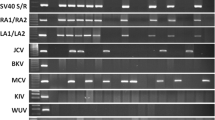Abstract
The monkey polyomavirus simian virus 40 (SV40) has been reported to be associated with tumorigenesis of human neoplasms, mainly brain tumors. However, it remains controversial whether the virus really exists in human neoplasms and how the virus transforms human cells in vivo. We investigated the presence of SV40 T antigen genome in 33 human glioma tissue specimens from Japanese patients with different histopathologies by means of the polymerase chain reaction (PCR) followed by Southern blotting. The SV40 T antigen genome was amplified in 4 of the 13 ependymomas (31%) and 3 of the 20 other histotypes of gliomas (15%), whereas in the 22 nontumoral brain tissue specimens, only one case was found to be positive. DNA sequencing confirmed the PCR products to be those of SV40 T antigen. The findings thus suggest that the SV40 genome appears to exist in a certain population of brain tumors from Japanese patients, and that it may also play a role in the oncogenicity or maintenance of the transformed state.
Similar content being viewed by others
References
Gerber P, Kirschstein RL (1962) SV40-induced ependymomas in newborn hamster. I. Virus-tumor relationship. Virology 18:582–588
Girardi AJ, Sweet BH, Slotnick VD, et al. (1962) Development of tumors in hamsters inoculated in the neonatal period with vacuolating virus, SV40 Proc Soc Exp Biol Med 109:649–660
Kirschstein RL, Gerber P (1962) Ependymomas produced after intracerebral inoculation of SV40 into newborn hamsters. Nature 195:299–300
Jansen F, Koprowski JF, Pagano JS (1964) Autologous and homologous implantation of human cells transformed in vitro by SV40. J Natl Cancer Inst 32:917–937
Shein HM, Enders JF (1962) Transformation induced by simian virus 40 in human renal cell cultures. I. Morphology and growth characters. Proc Natl Acad Sci USA 48:1164–1172
Fanning E, Knippers R (1992) Structure and function of simian virus 40 large tumor antigen. Annu Rev Biochem 61:55–85
Simmons DT (1995) Transformation by polyomaviruses—role of tumor suppressor proteins. in: Barbanti-Brodano G, Bendinelli M, Friedman H (eds) DNA tumor viruses. Plenum, New York, pp 27–50
Chang HT, Ray FA, Thompson DA, et al. (1997) Disregulation of mitotic checkpoints and regulatory proteins following acute expression of SV40 large T antigen in diploid human cells. Oncogene 14:2383–2393
Cory S, Adams JM (1988) Transgenic mice and oncogenesis. Annu Rev Immunol 6:25–48
Krieg P, Amtmann E, Jonas D, et al. (1981) Episomal simian virus 40 genomes in human brain tumors. Proc Natl Acad Sci USA 78:6446–6450
Krieg P, Scherer G (1984) Cloning of SV40 genomes from human brain tumors. Virology 138:336–340
Meinke W, Goldstein DA, Smith RA (1979) Simian virus 40-related DNA sequences in a human brain tumor. Neurology 29:1590–1594
Scherneck S, Rudolph M, Geissler E, et al. (1979) Isolation of a SV40-like papovavirus from a human glioblastoma. Int J Cancer 24:523–531
Soriano F, Shelburne CE, Gokcen M (1974) Simian virus 40 in a human cancer. Nature 249:421–424
Tabuchi K, Kirsch WM, Low M, et al. (1978) Screening of human brain tumors for SV40-related T antigen. Int J Cancer 21:12–17
Weiss AF, Portmann R, Fischer H, et al. (1975) Simian virus 40-related antigens in three human meningiomas with defined chromosomal loss. Proc Natl Acad Sci USA 72:609–613
Zimmermann W, Scherneck S, Geissler E, et al. (1981) Demonstration of SV40-related tumor antigen in human meningiomas by different hamster SV40-T-antisera. Acta Virol 25
Bergsagel DJ, Finegold MJ, Butel JS, et al. (1992) DNA sequences similar to those of simian virus 40 in ependymomas and choroid plexus tumors of childhood. N Engl J Med 326: 988–993
Martini F, Iaccheri L, Lazzarin L, et al. (1996) SV40 early region and large T antigen in human brain tumors, peripheral blood cells, and sperm fluids from healthy individuals. Cancer Res 56:4820–4825
De Mattei M, Martini F, Tognon M, et al. (1994) Polyomavirus latency and human tumors. J Infect Dis 169:1175–1176
Dorries K, Loeber G, Meixensberger J (1987) Association of polyomaviruses JC, SV40, and BK with human brain tumors. Virology 160:268–270
Krainer M, Schenk T, Zielinski CC, et al. (1995) Failure to confirm presence of SV40 sequences in human tumours Eur J Cancer
Kosaka H, Sano Y, Matsukado Y, et al. (1980) Failure to detect papovavirus-associated T antigens in human brain tumor cells by anticomplement immunofluorescence. J Neurosurg 52:367–370
Enjoji M, Iwaki T, Watanabe T (1995) IgH intronic enhancer HE2 (μB) functions as a cis-activator in choroid plexus cells at the cellular level as well as in transgenic mice. J Neurochem 64:961–966
Enjoji M, Iwaki T, Hara H, et al. (1996) Establishment and characterization of choroid plexus carcinoma cell lines: connection between chorid plexus and immune systems. Jpn J Cancer Res 87:893–899
Tognon M, Casalone R, Martini F, et al. (1996) Large T antigen coding sequence of two DNA tumor viruses, BK and SV40, and nonrandom chromosome changes in two glioblastoma cell lines. Cancer Genet Cytogenet 90:17–23
Lednicky JA, Garcea RL, Bergsagel DJ, et al. (1995) Natural simian virus 40 strains are present in human choroid plexus and ependymona tumors. Virology 212:710–717
Ewald D, Li M, Efrat S, et al. (1996) Time-sensitive reversal of hyperplasia in transgenic mice expressing SV40 T antigen. Science 273:1384–1386
Author information
Authors and Affiliations
Corresponding author
Rights and permissions
About this article
Cite this article
Suzuki, S.O., Mizoguchi, M. & Iwaki, T. Detection of SV40 T antigen genome in human gliomas. Brain Tumor Pathol 14, 125–129 (1997). https://doi.org/10.1007/BF02478881
Received:
Accepted:
Issue Date:
DOI: https://doi.org/10.1007/BF02478881



